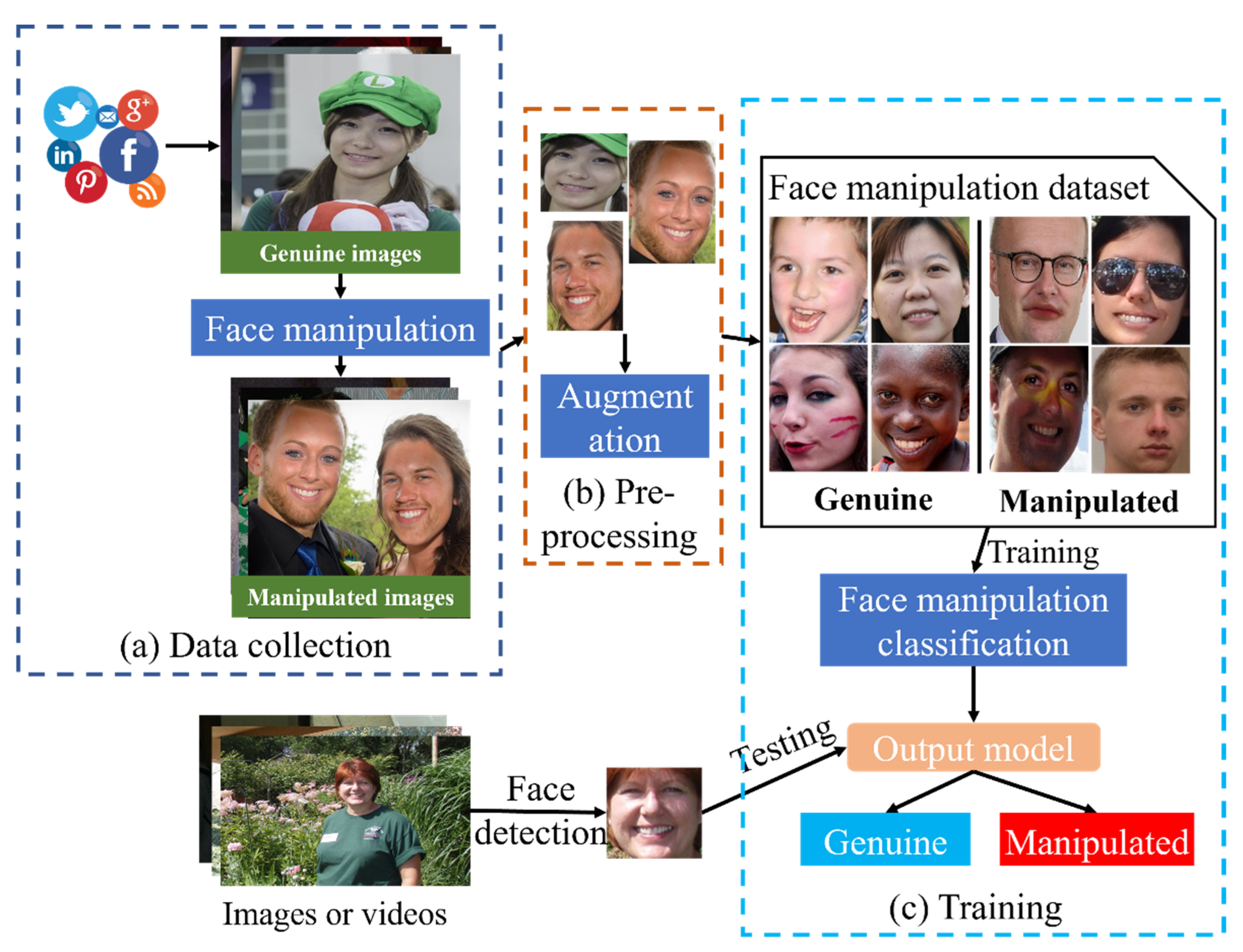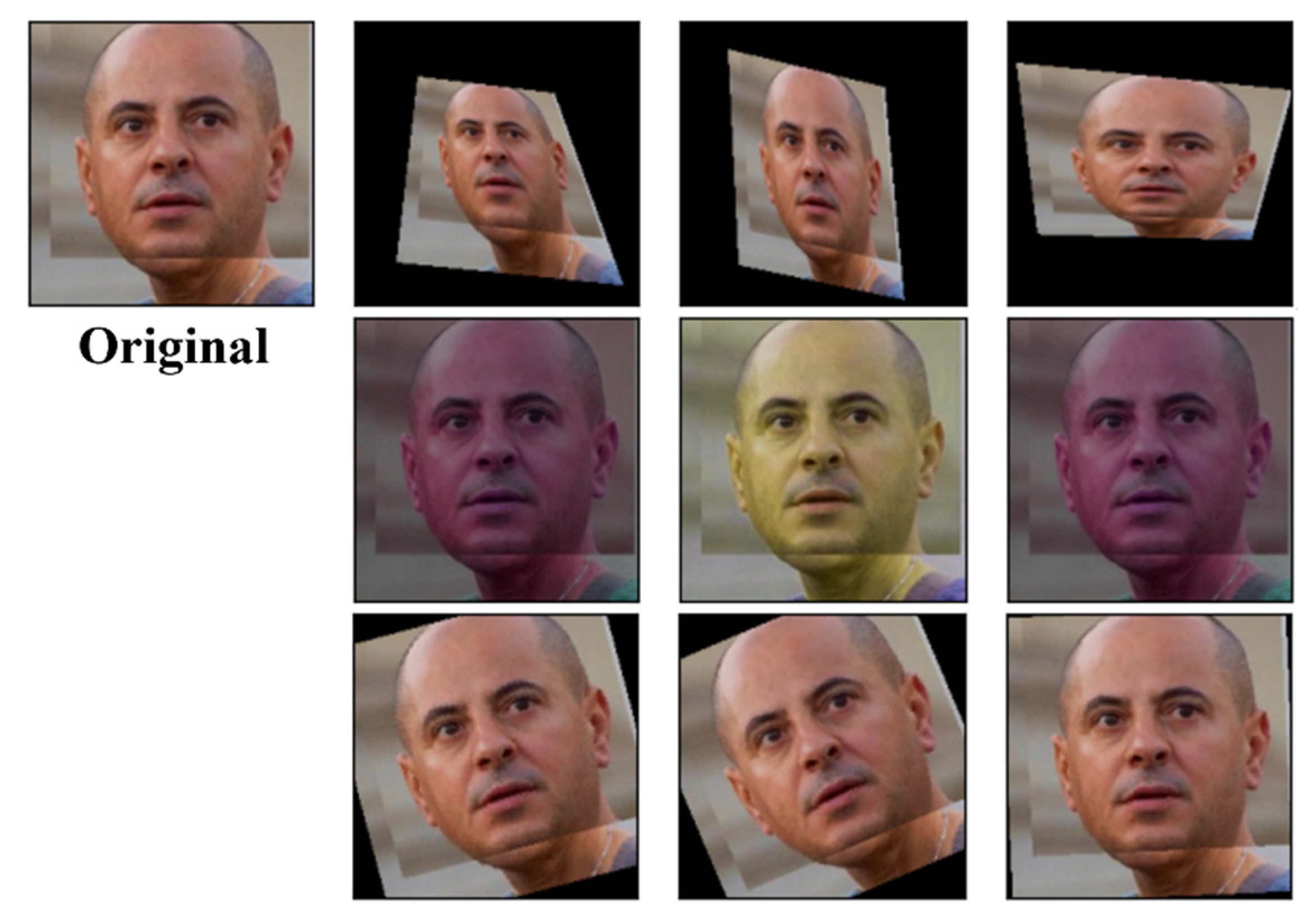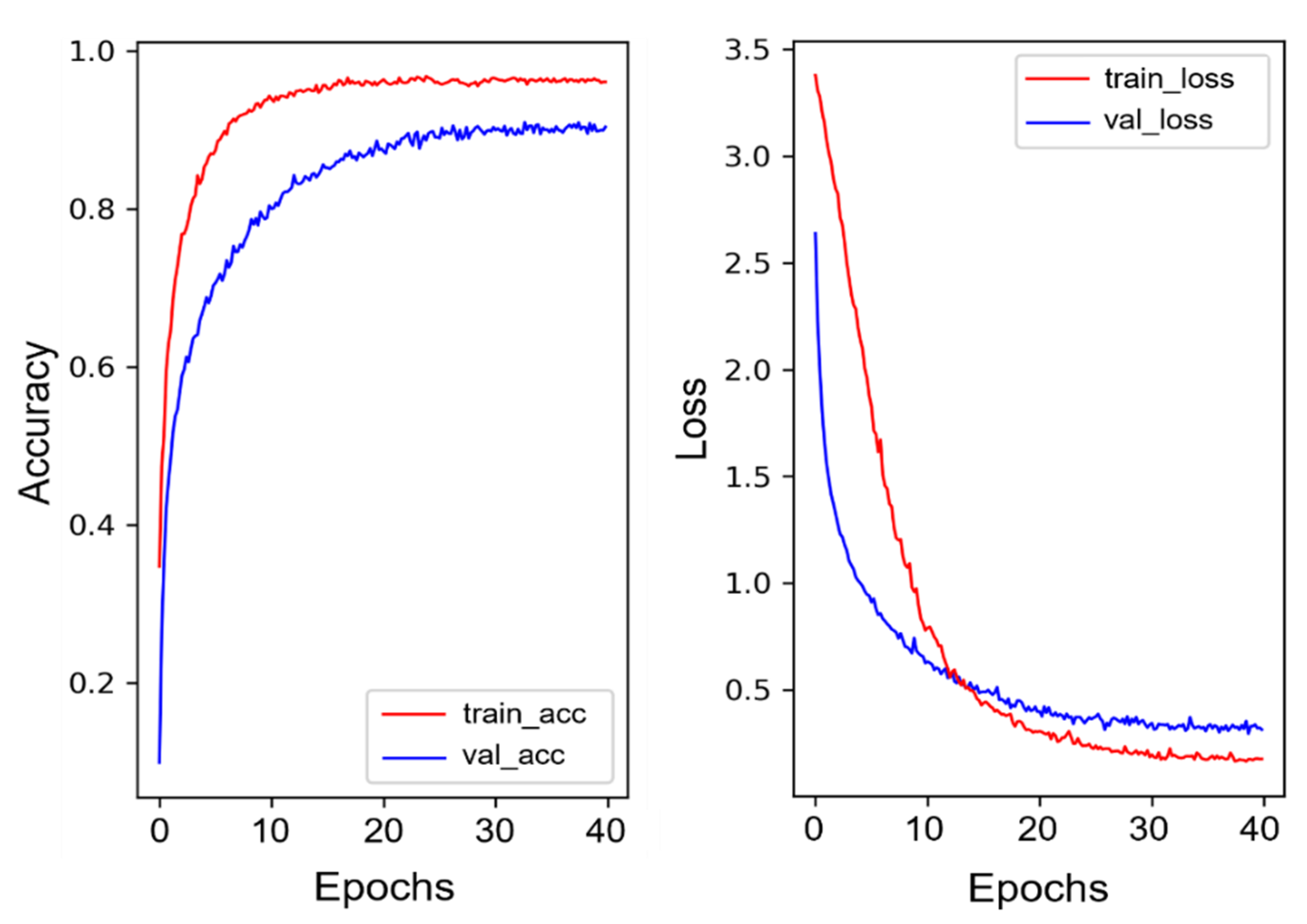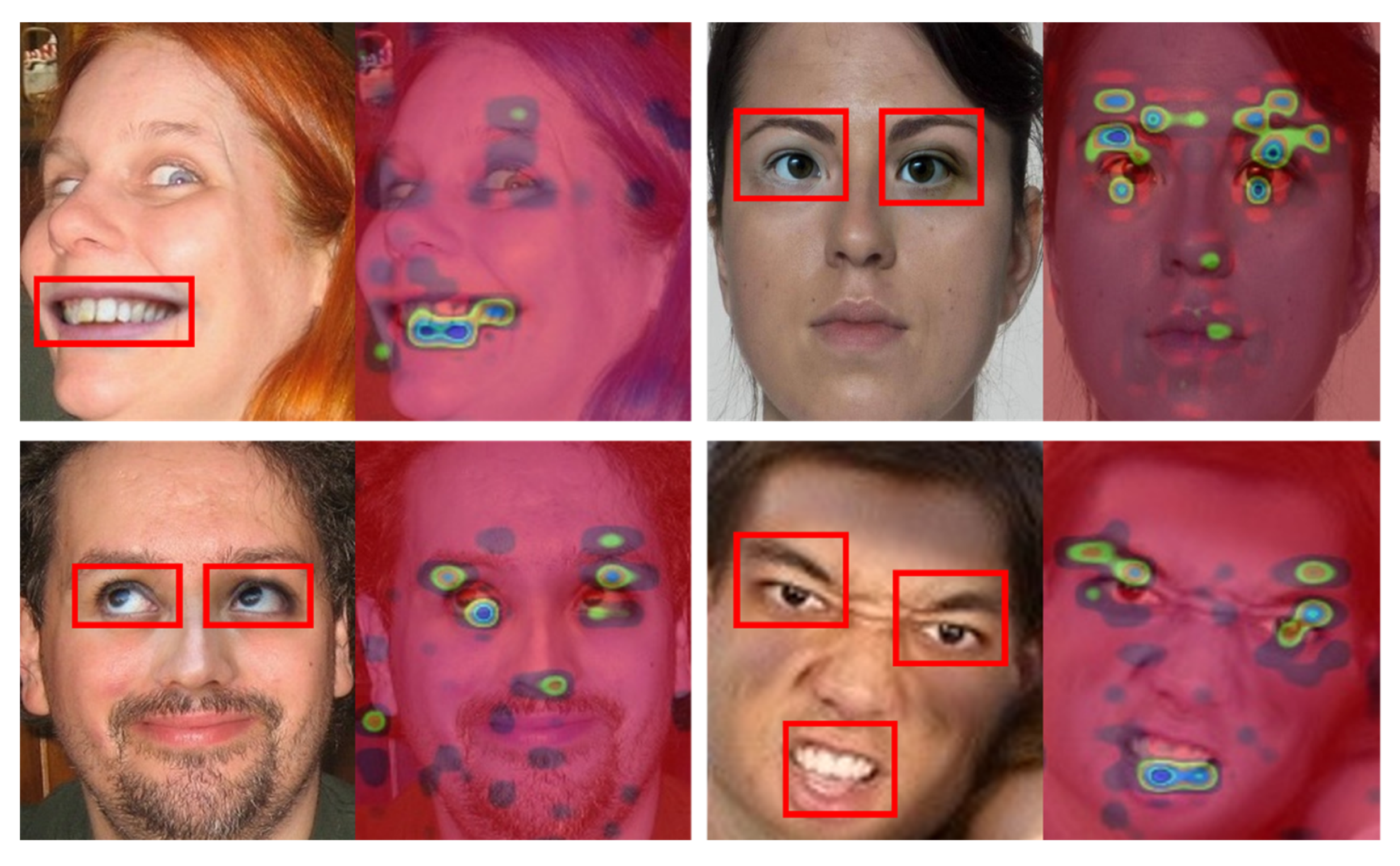1. Introduction
The human face is one of the most crucial factors in social interaction because it can be used to identify an individual’s identity and convey many different emotions. Therefore, the human face has been used extensively in our daily life for identity identification in applications, such as security, payment, and law enforcement [
1]. However, these advancements also draw various attacks from malicious people aiming to bypass the systems as genuine users. In addition, technological advancements have simplified the process of manipulating face images, enabling them to spread like wildfire on the Internet [
2]. As a result, it is critical to introduce effective and robust strategies to detect manipulated images created by facial forgery attacks to mitigate the negative impact and improve both privacy and security.
Common face image manipulation techniques are image splicing and copy-move forgery [
3]. The copy-move forgery is performed by copying regions of an image and pasting them into other regions of that image. With a different approach, image splicing refers to the process of taking some regions of a source image and putting them into a target image to create a composite image. Finally, various post-processing methods can be implemented to rectify the manipulated regions to make distinguishing between genuine and manipulated images more challenging [
4]. Moreover, it has become simpler for regular users to perform face manipulation via open-source software and mobile apps. The manipulated face images have been proved to fool face recognition models easily because those models recognize identity from the manipulated images as in authentic images [
5].
As manipulated images have become more straightforward to create and become highly realistic, research devoted to detecting face image manipulation has increased sharply in recent years. However, conventional machine learning (ML)-based models had various drawbacks because they relied mainly on manually extracting essential features from a specific dataset. Therefore, deep learning technology has been increasingly employed over traditional methods during the last few decades because it obtained state-of-the-art performance in standard computer vision (CV) topics, including vision-based manipulation detection [
1,
6].
This study introduces an automated manipulated face image identification system based on deep learning. We propose a large face manipulation database which was manually generated and validated. After, a fine-tuned RegNet-based framework for face manipulation classification was proposed. Finally, several test scenarios were introduced to verify the RegNet-based model’s performance on the collected dataset and against other models.
The remainder of the study is arranged as follows.
Section 2 briefly discusses previous face manipulation generation and detection approaches. After that, the fine-tuned face manipulation identification proposed in this study is explained in
Section 3. Various experiments are offered in
Section 4 to thoroughly evaluate the performances of the suggested model on the collected dataset and against previous models.
Section 5 shows a brief discussion about the proposed framework. Finally, we summarize and discuss the proposed framework in
Section 6.
2. Related Work
2.1. Conventional Face Manipulation Detection
Traditional ML-based methods for image manipulation have previously been extensively studied. However, these studies required a manual investigation and extraction of representative hand-crafted image features based on specific characteristics of the dataset under consideration, which was complicated and time-consuming. Some common techniques that are usually used to perform image forgery analysis are local noise estimation, illumination analysis, color filter array (CFA), steganalysis features, and double JPEG localization [
7]. For instance, Yao et al. revealed inconsistent noise levels from manipulated regions of RGB images using the noise level function (NLF) approach. The proposed method achieved high accuracy using the Bayesian inference on the dataset [
8]. Zhang et al. checked whether the quantization matrixes of the input images match well after implementing the double JPEG compression in order to detect manipulated images [
9].
Conventional ML models show poor performance when post-processing procedures, such as noise reduction and image blending, are performed to reduce noise consistency. Moreover, conventional models are well-fitted to small datasets and usually performed poorly with unseen data.
2.2. Deep Learning-Based Face Manipulation Detection
Deep learning is part of ML that uses artificial neural networks (ANN) with representation learning. Over recent decades, it has showed state-of-the-art performances in various applications, including classification, segmentation, and other domains [
6]. Current image manipulation identification studies have started to implement deep learning. For example, Mayer et al. introduces an image forgery detection framework using deep learning that automatically extracted representative features from input images [
10]. The obtained results revealed that the system identified three types of image manipulation with an average accuracy of 99%. With a different approach, Zhou et al. [
11] represented a novel deep learning-based image manipulation detection framework that learned two different features, including RGB color and noise features. The authors proved that the extracted two features significantly improved the model’s performance and robustness on images generated by various tampering methods.
Recently, neural architecture search (NAS), a procedure for automating deep learning design, has gained popularity [
12]. It relies on a neural structure search technique to propose an optimal structure based on the search space settings, such as computing expense and optimal parameter set. Representative models based on NAS technology that have obtained state-of-the-art performances are EfficientNet [
13] and MobileNetV3 [
14]. Compared to these NAS-based models, the novel NAS-based RegNet model is different because the authors designed the network design spaces that parametrize populations of networks instead of concentrating on developing individual network instances [
15]. RegNet has shown higher performance and fivefold faster speeds than the state-of-the-art EfficientNet model. As a result, this research proposes to fine-tune the RegNet model for performing face manipulation identification.
3. Methodology
The overall description of the proposed manipulated face classification framework is illustrated in
Figure 1, which has three main processes. The first process is data collection, which gathers images containing human faces from the Internet. Then, various regions from the faces of the genuine images are altered to make manipulated face images. After that, both genuine and manipulated images are fed into the preprocessing process, including two sub-tasks. First, faces from those images are extracted and rescaled to a predefined size. Next, various image augmentation methods are implemented on both the authentic and manipulated datasets to enhance the model’s performance and robustness. Finally, the preprocessed images are used to train different models to identify manipulated face images.
3.1. Data Collection
This section explains the process of collecting images for the dataset with their statistics. Even though various face manipulation datasets have been proposed, they contain only a limited number of images and people. For example, a high-resolution DSI-1 face manipulation dataset was proposed by De Carvalho et al. [
16], which only contains 25 images. On the other hand, large and challenging image manipulation databases, such as the CASIA V2 dataset [
17] and the Columbia image splicing detection dataset [
18], mainly comprise various objects without human faces. As a result, a huge and high-quality face manipulation dataset was proposed in this study, which supports the development of robust manipulated face image classification models.
A crawler was initially developed to automatically collect human face images from social media sites and search engines, such as Google Images and Baidu. A total of 5,650 authentic images were downloaded, which involved varying poses under different illumination and surrounding environments. Moreover, the downloaded face image collection also covered a broad range of nationalities, genders, accessories, and facial hair.
Based on the collected genuine images, a team of 5 members took part in a manipulated face image generation task using various image manipulation approaches that lasted for two months. Each person made about 20 images per day on average. At the end of this process, 4188 manipulated face images were generated and validated manually. The image size ranges from 82 × 82 to 1098 × 1098.
Figure 2 displays nine sample images for authentic and manipulated face images from the proposed dataset. Advantages of the dataset over existing datasets include (i) having the primary purpose of detecting face manipulation, and (ii) high quality manipulated regions of the faces and realistic manually made images.
3.2. Preprocessing
3.2.1. Face Detection
The faces are the main priority of this study as they contain all manipulated regions. Therefore, other unnecessary parts of the image can be removed to improve the training efficiency. A face detection approach using facial landmarks was implemented by an open-source toolkit named dlib to detect all of the faces [
19]. This library uses a pretrained support vector machine (SVM) to extract all faces in an image trained on Histogram of Oriented Gradients (HOG) features.
3.2.2. Data Augmentation
Three standard data augmentation methods, including color jitter, random rotation, and random perspective, were implemented to generate more training images and improve the framework’s performance and robustness. Sample images created by the data augmentation process are displayed in
Figure 3. Finally, all detected face images are rescaled to 224 × 224.
3.3. Manipulated Face Identification Model
As illustrated in
Figure 4, the proposed manipulated face identification framework was motivated by the RegNet network architecture [
15], which includes three main modules: stem, layer, and head. The input of the model was 224 × 224 RGB images, whereas the output was a binary classification result of two classes for a genuine or manipulated image.
The stem module is a crucial part of the generic ResNet/ResNeXt architecture, which includes a 3 × 3 convolutional layer (Conv) and a batch normalization (BN) to shrink the spatial size of the input quickly. Next, the layer module consists of a set of residual blocks. Each residual block includes a set of 1 × 1, 3 × 3, and 1 × 1 convolutional layers with BN and a ReLU activation function following each convolutional layer. Finally, the extracted features go through the head module containing the pooling and fully connected layers. The pooling layer is normally applied to shrink the spatial size of the extracted feature maps. This study used an adaptive average pooling with an output size of 1. Finally, a fully connected layer (FC) was implemented to predict one of the two classes, genuine or manipulated, based on the output features.
A cost function has the main objective of minimizing the training loss during the training stage. Cross-entropy loss, which is a standard cost function for classification problem, is selected as the primary cost function in this study [
20]. The problem under consideration in this study is a binary classification problem with two classes—manipulated and genuine. The binary cross-entropy can be defined as follows.
where
is the ground truth value taking the value of 0 for genuine class and 1 for manipulated class.
is the linear probability for the
ith class. To optimize this loss value, Adaptive Moment Estimation (Adam) optimizer [
21] was implemented. Adam is an adaptive learning rate optimization approach that considers both scaling and momentum. The method is effective and requires less memory when coping with complex topics involving a lot of data or parameters. The Adam weight update rule
with respect to the parameter
at time step
t is performed as follows.
where
and
are bias-corrected first moment (the mean) and the second moment (the uncentered variance) of the gradients respectively. We follow the default hyperparameter values proposed in the original paper [
21] and not using parameters
= 0.9,
= 0.999, and
= 1× 10
−8. Finally, the step size
is set to 0.001 to optimize the binary cross-entropy loss value.
4. Experimental Results
The experimental results section represents various test scenarios carried out to verify the proposed model’s performance. All experiments were performed on an Ubuntu 18.04 NVIDIA deep learning workstation with an Intel® Core i7-5930K processor, 128GB of DDR4 RAM, and two 12GB Titan X GPUs. The face manipulation identification framework was programmed and trained using PyTorch, an open-source and well-known deep learning library. In order to ensure fairness in the following investigations, the transfer learning technique was implemented for all the models using the corresponding pre-trained models on the ImageNet dataset [
22]. The batch size during the training process of all models was fixed to 64. The models were trained for 40 epochs.
The first experiment is implemented in
Section 4.1 to test the sensitivity of some crucial hyperparameters.
Section 4.2 show the proposed model performance on the proposed dataset using a cross-validation setting. After that, the model performance compared to previous deep learning models using the proposed dataset was also de-scribed. Finally, we show a visualization of the detected manipulated regions that helped the model in predicting the class in
Section 4.3.
4.1. Hyperparameter Analysis
The hyperparameters are essential factors enabling high classification performance and fast convergence speed.
Table 1 demonstrates how different sets of loss functions (cross-entropy and focal loss), optimizers (SGD and Adam), and learning rates (0.01 and 0.001) affect the RegNet model performance. The variations using the focal loss function and the Adam optimizer showed slightly higher classification accuracy than the cross-entropy loss and the SGD optimizer. Therefore, the loss function and the optimizer influenced the model performance. It can be concluded that the RegNet model showed the highest performance of 89.4% when focal loss, Adam optimizer, and a learning rate of 0.001 were applied. As a result, we used them as the default hyperparameter settings for the following experiments.
4.2. Face Manipulation Classification Performance Analysis
In this experiment, 5-fold cross-validation was implemented on the proposed database in order to eliminate the overfitting issue and boost the classifier robustness.
Table 2 shows the number of genuine and manipulated images for training/validation for each fold and the corresponding validation accuracy of each fold. Overall, the proposed model achieved stable performance for five folds with acceptable oscillations of 3.8% and an average accuracy of 87.95%. Fold 5 showed the highest face manipulation identification accuracy of 89.71%.
Figure 5 represents the training and validation accuracy and loss for Fold 5, which achieved the highest performance among the five folds. The proposed model’s training and validation accuracy increase sharply to above 80% and 75%, respectively, after epoch 5 and stop at 97% for training and 89% for validation at the end of the training process. The computed error values decline gradually and stop at 0.4 for the training and 0.2 for validation at epoch 40.
The main goal of the following investigation is to demonstrate the superiority of the suggested model over existing models, which includes EficientNet [
13], ResNet-50 [
23], and MobileNetV3 [
14], on the collected manipulated face dataset. Other required hyperparameters for each model were set strictly following the descriptions from the original papers.
Table 3 describes the experimental results of all models in terms of classification accuracy. Among the models, the proposed fine-tuned RegNet-based model obtained the highest classification accuracy of 89.71%, which was 6.47% better than the MobileNetV3 model. On the other hand, the NAS-based EfficientNet and ResNet50 achieved slightly slower performances than the proposed model at 88.05% and 86.85%, respectively. Both RegNet and EfficientNet contain a similar number of trainable hyperparameters. RegNet required 21 ms to process a single image, whereas the inference time was slightly faster for EfficientNet at 19 ms.
4.3. Qualitative Evaluation and Manipulated Region Analysis
Figure 6 quantitatively describes the outputs of the proposed model for four genuine face samples and four manipulated face samples. The fine-tuned RegNet model correctly distinguished between genuine and manipulated face images with high classification confidence.
In order to further interpret how the model made a specific prediction, a class activation map (CAM) technique was implemented. CAM reveals how the model correctly utilizes the trained weights to identify manipulated input images. It projects weights for each class from the previous layers back to feature maps of the final FC layer to highlight crucial manipulated regions.
Figure 7 reveals that the manipulated areas from the original images were accurately projected in the corresponding CAM results. As a result, it can be concluded that the model identified a manipulated image based on analyzing related regions.
5. Discussion
The experimental results revealed that the RegNet-based manipulated face identification framework and the proposed dataset are essential to promote developments in face forgery detection. First, this study introduced a manually collected and validated face manipulation dataset that mainly contains high-quality images that can be used for future studies as a benchmark dataset. Second, the framework was based on the state-of-the-art RegNet model, which is straightforward to deploy in popular deep learning libraries, such as Tensorflow and PyTorch. Third, the proposed model achieved the highest manipulation classification performance of 89.7% compared to other state-of-the-art deep learning models (EfficientNet [
13], ResNet-50 [
23], and MobileNetV3 [
14]), which was appropriate for applications that focus more on performance than computational complexity. Finally, we proved that the model correctly recognized crucial manipulated regions by projecting weights for each class from the previous layers back to the feature maps of the final FC layer.
6. Conclusions
This study proposed a RegNet-based face manipulation identification framework. First, a manipulated face dataset containing a considerable number of high-quality images that were manually validated was proposed. The fine-tuned RegNet model overcame the challenges of conventional approaches by automatically extracting representative abstract features. In addition, several techniques were implemented to improve the performance of the proposed model, such as preprocessing and transfer learning. The proposed model set a high face manipulation classification performance with the highest accuracy of 89.7%.
The following weaknesses can be solved to boost the model’s performance further. First, even though the framework showed high performance on RGB images, it is essential to study manipulated images using other color channels, such as infrared, in order to explore potential practical inputs for face forgery identification. Second, more preprocessing methods, such as rescaling and whitening transformation, can be applied during the collection of the manipulated face dataset to make it more challenging. Finally, the current framework was unable to reveal the exact locations of the manipulated regions, which can be addressed by training an object detector.













